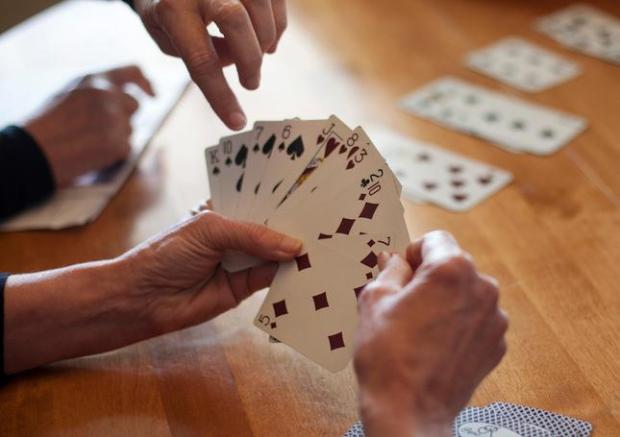Whether your bridge-playing family or friends have convinced you to take up the mantle, or whether bridge’s brain benefits or some other reason have motivated you to learn the game, you’re about to embark on one of the toughest and most rewarding journeys of your life.
What’s the Best Way to Learn to Play Bridge?

What’s the Best Way to Learn to Play Bridge?
by Katie Coopersmith © 2017 for Great Bridge Links
So you’ve finally decided you want to learn how to play bridge.
First of all, congratulations! Many people take their entire lives to come around and realize just how magnificent a game bridge can be – or else they never realize it – so you’re already largely ahead of the pack just by setting an intention to learn how to play!
Whether your bridge-playing family or friends have convinced you to take up the mantle, or whether bridge’s brain benefits or some other reason have motivated you to learn the game, you’re about to embark on one of the toughest and most rewarding journeys of your life.
There’s only one question remaining: how on earth does one simply learn how to play bridge? In the technology-saturated, DIY-cultured world we live in, it can seem almost impossible to choose and stick to just one method. However, it’s important to find a method or two that really works for you because we all learn and process information differently, so finding the right way to learn bridge can seriously improve your chances both of enjoying the game and of getting super good at it.
In this article, we’ll explore some of the pros and cons of some different bridge learning methods. Tune in, deal out, and get ready to play!
Take private lessons
Pros: Haven’t taken a private lesson in anything since you were eight years old? Never fear! Private bridge lessons can be a fantastic way to pick up the basics of the game with the help of an understanding teacher. There are no stupid questions when you’re in a private lesson! One of the biggest pros of taking one-onne lessons is that you can feel free to ask your teacher literally anything about gameplay, bridge lingo that you don’t understand, the social conventions of bridge, and more.
Cons: Private lessons can be costly, and the money you’re spending might feel wasted if you don’t see quick improvement. Also, private lessons mean that you miss out on the social aspect and new friends available in group lessons. You won’t meet anyone that you can spontaneously call up on a weeknight and ask to practice together (unless you befriend your teacher, that is!)
Take group lessons
Pros: If you want to soak up the expertise of a teacher while also taking advantage of the social benefits of bridge, group lessons are the way to go. Many people play bridge principally because it allows them to spend quality time with their peers. You can either start a lesson group that includes people you’re already friends with, or join a group full of strangers and run the risk of making friends for life. Many local bridge clubs host group lessons. You can find a bridge club in your area through one of the links on the Great Bridge Links club page.
Cons: When you take bridge lessons in a group, it can be somewhat harder to get the attention you want from your teacher. You may not be able to have all of your questions answered, and you may struggle to keep the group flowing happily if certain members’ levels improve faster than those of other members.
Teach yourself using books/the internet
Pros: The pros and cons of autodidacticism (teaching oneself) are really contingent upon who you are. Self-starters, introverts, and naturally curious people who enjoy teaching themselves new skills will probably really enjoy teaching themselves using books or the internet. Check the links and information on Great Bridge Links Learn to Play page if you’re thinking you’d like to teach yourself.
Cons: If you don’t fit the personality type described above, however, you might seriously struggle with the massive task of teaching yourself how to play bridge and quit in frustration. If you don’t like teaching yourself new skills, or if you are easily frustrated, we strongly encourage you not to try to teach yourself bridge solo!
Learn using computer software
Pros: Robert Hartman, CEO of the American Contract Bridge League (ACBL), has said “There’s no doubt anyone can learn” to play bridge. The ACBL, he says, offers “a number of programs…[that] make it simple”. Hartman is right, as it turns out. The ACBL offers a new Learn to Play Bridge software program, which includes a learn-as-you-play tutorial; a five-hour course for beginners called Learn Bridge in a Day; and many free personal computer software programs. These programs are all free or affordable, and best of all, they can be done on your own time, from the comfort of your own home. Some are even available in app form!
Cons: One of the downsides of using computer software, which also applies to the method of teaching oneself using books or the internet, is that it can be difficult to stay motivated when you don’t have a preset learning or lesson schedule or a teacher to keep you accountable. If you do choose this method, consider making a schedule for your bridge software sessions, and checking off all of the lessons you complete. Another downside is that this method can be difficult for those who struggle with computer technology.
Watch Youtube videos
Pros: Doesn’t sound like the most traditional method, does it? Nowadays, however, just about any skill can be picked up with the help of a good Youtube tutorial (or better yet, a good Youtube tutorial series…) – and there are many videos out there designed to teach people how to play bridge! They’re short (usually), and easy to consume because of their bite-sized format. It’s easy to take notes while watching, and you can pause to take a break anytime.
Cons: Although you can sometimes contact Youtube videos’ creators through the website, they’re not really your teacher, so it can be difficult to ask questions and actually get answered. Just like we talked about earlier with the methods of teaching yourself through the internet and books or using computer software, it can be hard to keep yourself motivated when you use this method.
Great Bridge Links has been working on a collection of YouTube links for learning and practicing and enjoying bridge. You can find that page here
Pick Your Poison and Play Play Play!
Nothing is better for learning the game than time at the table. Play bridge as much as you can. Play with your family, your friends, your kids. Start a home bridge night in your neighbourhood! My mom, a national champion and a bridge teacher, started playing bridge at a kitchen table with a big group of friends. Whenever someone was dummy, someone new would swap in and have a turn. She played lots of kitchen bridge, sometimes for whole weekends, and lots of club bridge.
That was during the 1970s. These days, with online bridge clubs and services suitable for players at all levels, you can play with friends – or robots – 24/7 and you don’t even have to worry about finding three other players.
No matter which method you choose to help you learn bridge, it’s always necessary to do your own studying outside of your designated lesson or learning time if you want to improve! Read bridge books and magazines, listen to bridge podcasts, and pick the brains of your bridge-playing friends.
If you find that the method you’ve chosen doesn’t work for you, the beauty is that you can just switch to another method with fairly little fuss! Once you start learning bridge, we can almost guarantee you’ll be hooked…and who knows, one day, you might be teaching it!
Great Bridge Links has an excellent page of Learn to Play resources. You’ll find website links, software links, and more. As well, be sure to visit our Bridge Stories blog for some fun reading. And when you’re ready, check out our Bridge Basics section.
***
RELATED ARTICLES
New in 2024 – What is the best way to learn bridge








